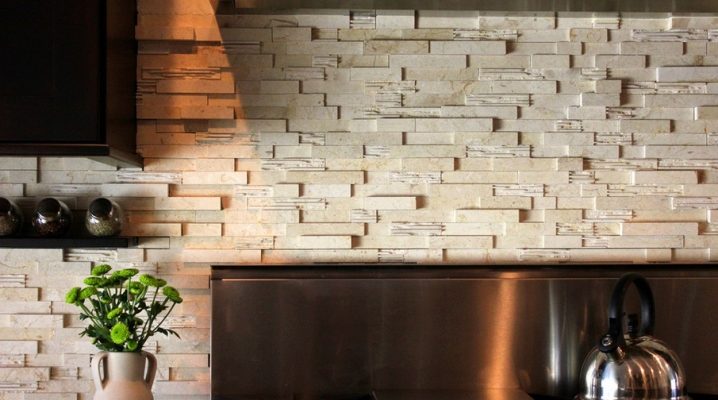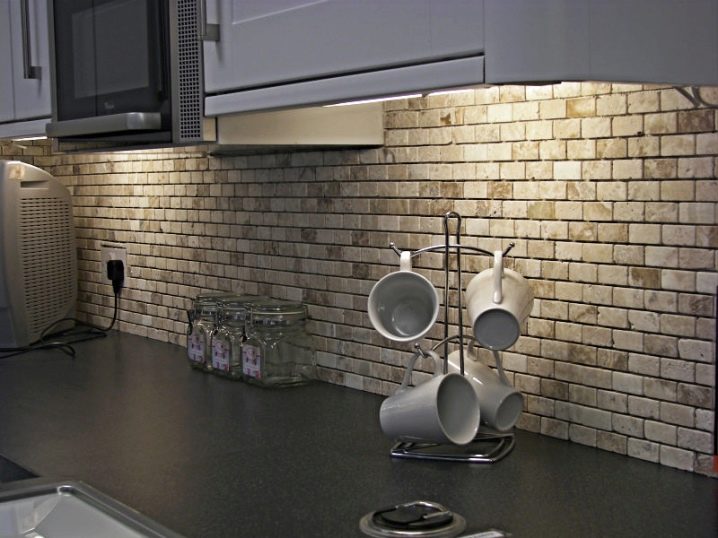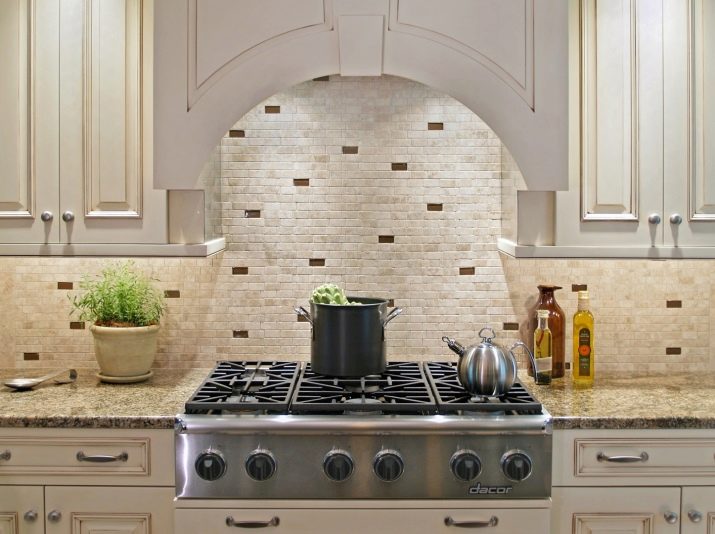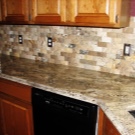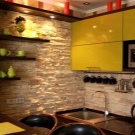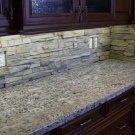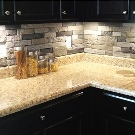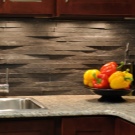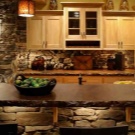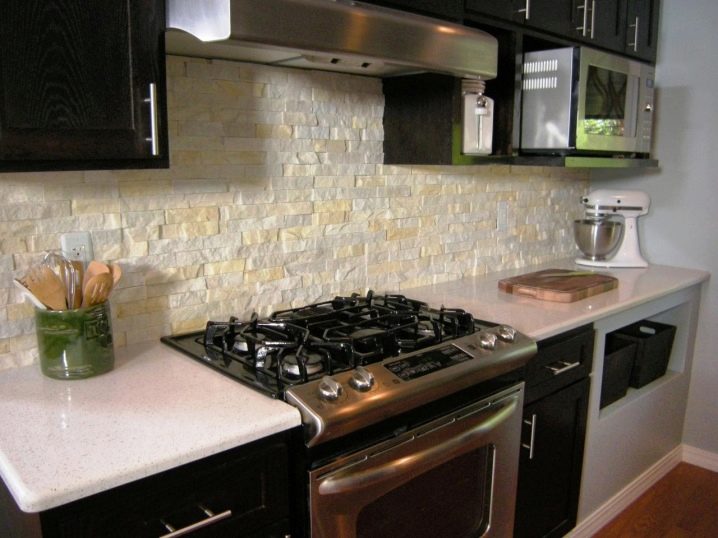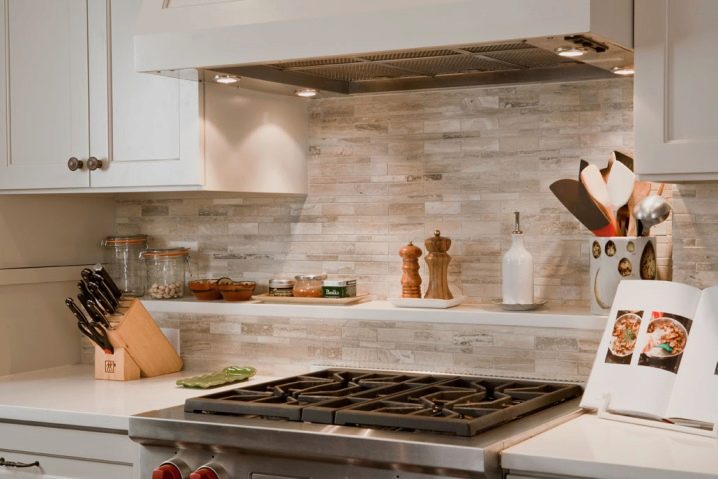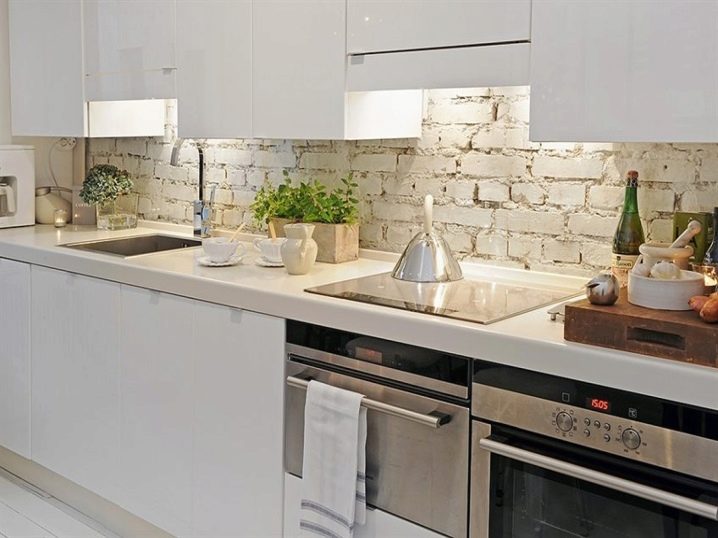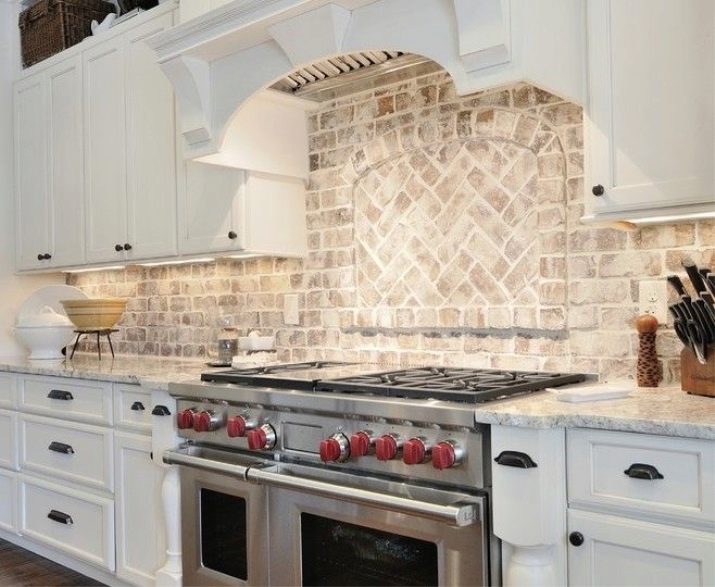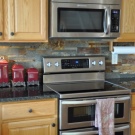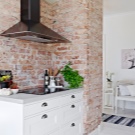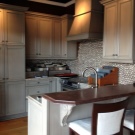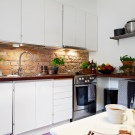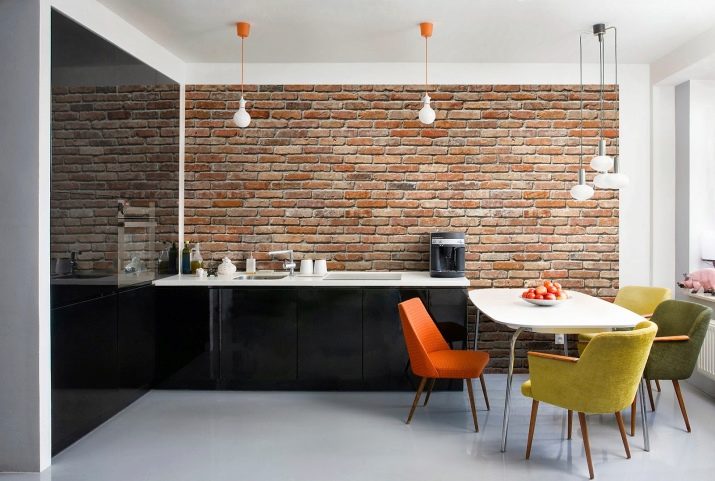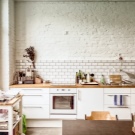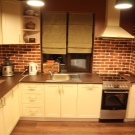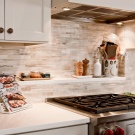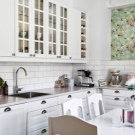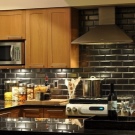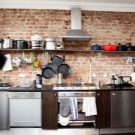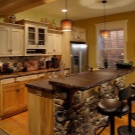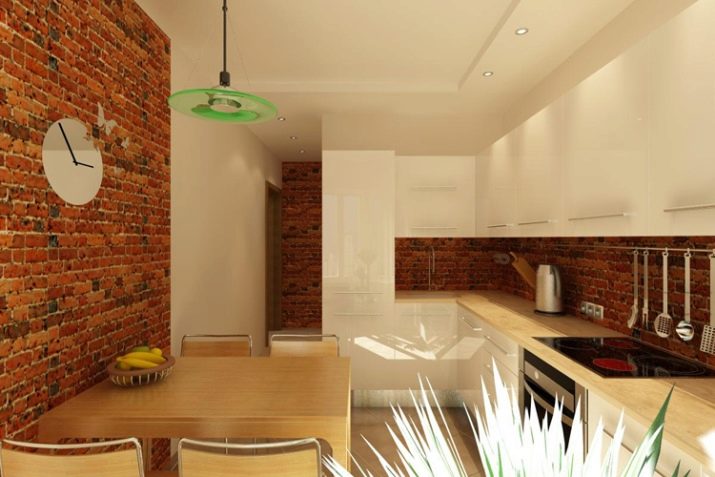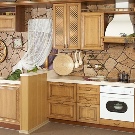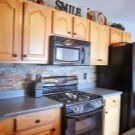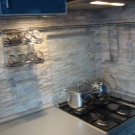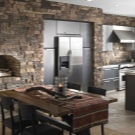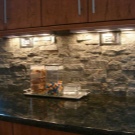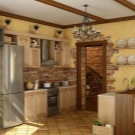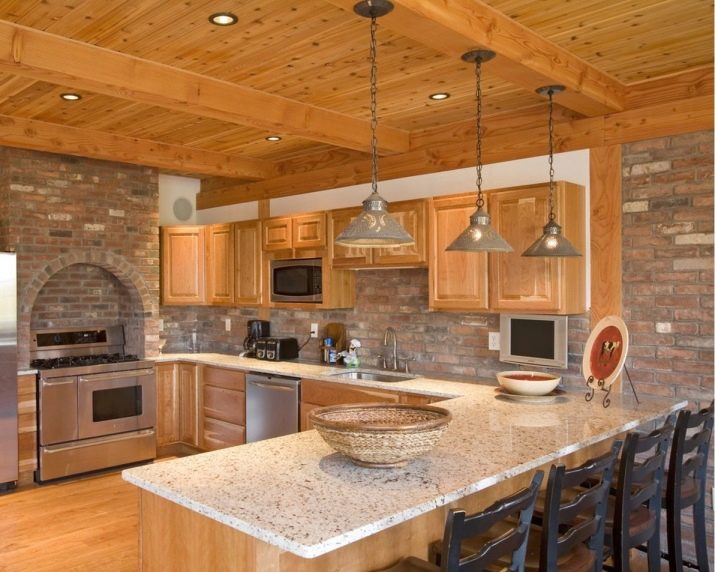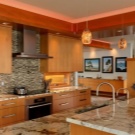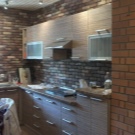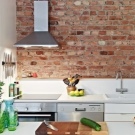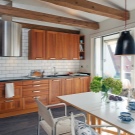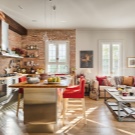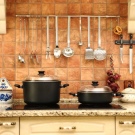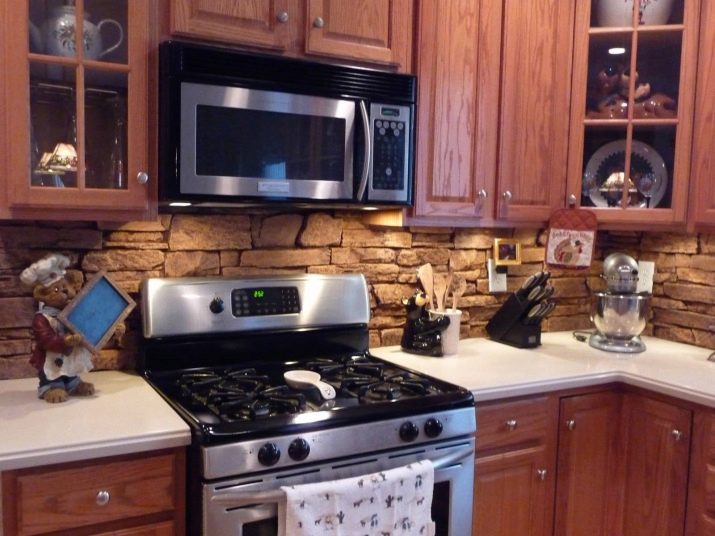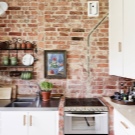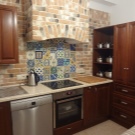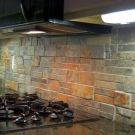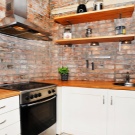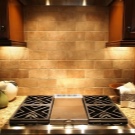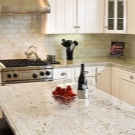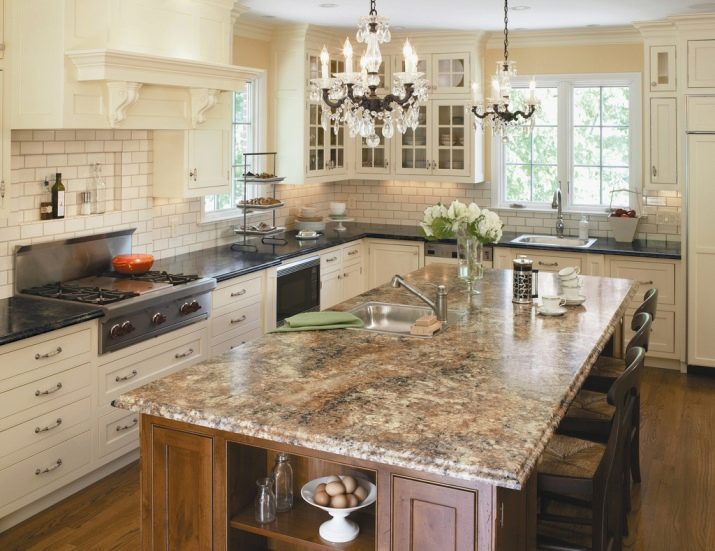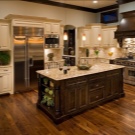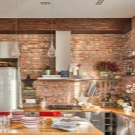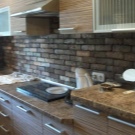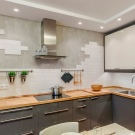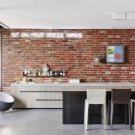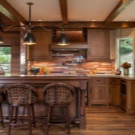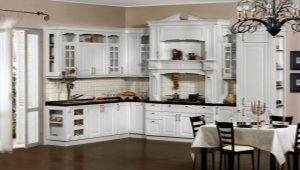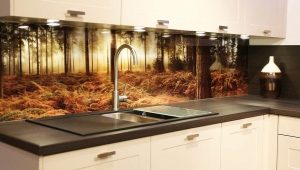Stone for the apron in the kitchen
Facing stone is very popular in the decoration of kitchen aprons. Due to the high cost, it is inferior in popularity to ceramic tiles, but it looks more noble and aristocratic. If you want to save on price, then you can find a cheaper alternative - an artificial stone. It is often used in the interior decoration styles loft, Provence, vintage, etc. The most affordable price is clinker, more expensive - marbled, granite, sandstone, basalt.
Species
In the market there is a huge number of types of decorative stone. When choosing it is important to make a start not only from the cost, but also from the quality, aesthetic beauty. The most popular remains porcelain, which is produced by a special technology. Making a kitchen apron in this way, you get a luxurious and elegant workplace with excellent material characteristics.
Its water absorption is 0.5%, and the hardness is 9 on the Mohs scale, so you do not have to worry about the formation of greasy, oily stains, dirt on the surface. It is enough to walk on it several times with a damp cloth to return a neat look to such material. Natural marble also demonstrates excellent resistance to moisture. From porcelain stoneware it's time to create an original design, an apron of standard width.
Interestingly, such elements will look in the performance of agglomerates. The composite is made on the basis of polyester resin, stone filler (marble, limestone crumbs). To make an artificial stone as close to natural as possible, a mineral dye is added to it at the production stage. A distinctive feature of the agglomerate is its light weight, therefore, to mount and decorate the wall with its help is quite real.
"Weakness" of the material is susceptibility to the action of sunlight. Its organic base also does not tolerate temperature drops. If a greasy stain is not noticeable on such a surface, then a hot pan and a frying pan mounted on an agglomerate countertop apparently “inherit”.
Another popular material for finishing and facing a kitchen apron is decorative concrete. It contains sand and various fillers. Quite often it imitates facade stone, for example, tuff, sandstone. The main advantage of this stone is a high aesthetic performance, bright, catchy texture.
Experts advise to use decorative concrete for fragmentation, decoration in a rustic or country style. Exquisitely similar facing will look like a “wild” stone for an apron in the kitchen, which will add charm and respectability to any interior.
Benefits
An important advantage of the stone is a wide palette of colors. It can be mounted on the wall, on the tabletop, on the floor, making out the kitchen design to your liking.
A glossy and matte variety of such material can come with or without texture, have relief, numerous fastenings, etc. Quite often, an texture resembling a natural stone, for example, quartz, various volcanic rocks, is chosen. To give a charming background for a furniture set, use a monolithic panel (white, cream, sand).
It is important that there are no pores in the artificial stone. Due to this, moisture does not seep through the material; grease and various contaminants do not enter the surface. Smooth, it is very easy to clean it using various chemical compounds, detergents. Under the influence of moisture, the apron under the stone will not wear out or deform.
He is also "not afraid" of temperature changes, fungus and mold. A characteristic advantage for artificial stone is the absence of seams. If you are aiming for a monolithic surface without fasteners, lining or joints, this material will suit you 100%.
Many acquire similar products due to their easy restoration. If over time chips appear on them, scratches, other mechanical damages, then for a small cost the material can be polished, returning its former attractiveness. Many people prefer to make an apron, countertop, sink and hob in one color. It is also possible to create a bar counter, a window sill from stone, emphasizing its gloss and elegance.
Installation
Before you install a kitchen apron made of artificial stone, it is desirable to measure the dimensions of the surface, shape.When using acrylic models, you can play around with curly edges, preferring not straight lines, but a rounded, delicate Provencal motif. Whatever the stone, its bottom should “hide” a couple of centimeters under the floor cabinets.
The important properties of the material make it possible to create an interesting figured transition from tabletop to apron with round or sharp corners. You can design your kitchen in avant-garde, classical, baroque, rococo, etc.
The decorative concrete shaped stone very much reminds an unpolished tile, a laying of any natural stone. A polyester stone will look great on the kitchen walls. Despite the fact that it is sensitive to some chemical aggressive substances, it still tolerates temperature fluctuations. Almost the same properties shows acrylic stone cold-cured. On the other hand, acrylic has a spectacular appearance, perfectly decorates the kitchen in an expensive extravagant atmosphere.
Laying decorative stone is made in stages. First, the walls are smoothed, cleaned, and then professional glue is applied with a spatula.To make, for example, an apron with visible seams, the tile should be installed with restrictive crosses. After solidification of the binder, these elements are removed, and the seams are sealed with a special grout (in tone or contrast tone of the material itself).
Stone slabs are best fixed from the corners. At any time, the finished surface can be treated with a solution for greater thermal protection. Numerous reviews in the network confirm the importance of applying a protective layer, which will become a “barrier” for the sedimentation of dust, microparticles, grease stains and other contaminants.
Style decisions
Due to the fact that the stone facing has a lot of varieties, it is possible to design the interior in many styles. For example, imitation for onyx, marble, granite is suitable for classics. Add to this list labradorite and malachite - and you will receive an exquisite Baroque style, rocaille.
A kitchen apron made of porcelain stoneware or agglomerates will perfectly decorate Provence, country, and Chebbi-chic atmosphere. But for the modern modernity, hi-tech, such lining is not suitable. At best, you can use a mix of several contrasting colors.
To protect the material resorted to special solutions, clear lacquers. They increase the strength of the stone and its resistance to external stimuli. Stone "jungle" in the kitchen is suitable for styles of techno, loft, industrial. Try to use monolithic, seamless plates, not naughty in the care. If you are trying to create a background for a headset, kitchen textiles, look at the options with an expressive pattern, but not a rich color range.
Preferring natural or artificial stone, you should be a fan of medieval, Mediterranean, marine style, as well as the Renaissance, Art Nouveau, Gothic, seasoned British style and others.
Facing form
Stone trim can be great to decorate the interior of both small and large kitchens. For this useful method lining plates. In this case, you will not encounter seams using a solid, durable, solid slab. Let your choice be on porcelain stoneware, which is ideal for rectification, and provides easy installation. Such finishing is recommended with the help of professional specialists.
Tiling method is inherent in the finishing of agglomerates of artificial concrete stone. The latter perfectly reproduce brick masonry. In this case, you can install the kitchen apron yourself. The same material is involved in the formation of wall panels.
To heighten the effect, use stones of various rocks. In the building materials market there is an experience of creating a mosaic of sinter, concrete, sandstone, limestone. All this looks more than gorgeous, if properly assemble the puzzle.
